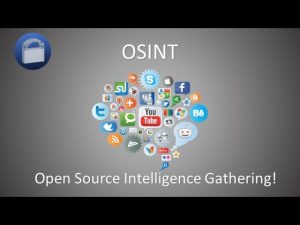Open-Source Intelligence (OSINT) is a critical component in the field of cybersecurity, offering valuable insights by analyzing publicly available information. This blog explores what OSINT is, how it works, how hackers utilize it, its relationship with cybersecurity, various OSINT tools, and the challenges associated with it.

What is OSINT?
Open-Source Intelligence (OSINT) refers to the practice of collecting and analyzing information from publicly available sources. Unlike classified intelligence, OSINT relies solely on data that is legally accessible to the public. This data can come from a variety of sources, including:
- Social media platforms
- News articles
- Public databases
- Websites
- Government reports
OSINT helps organizations understand the broader information landscape, identify potential threats, and make informed decisions.
How OSINT Works:
Data Collection:
The first step in OSINT is gathering information from diverse public sources. This includes websites, social media, news outlets, forums, and other online platforms. Advanced search techniques and automated tools can help in collecting large volumes of data efficiently.
Data Processing:
Once the data is collected, it needs to be processed to remove irrelevant information. This involves filtering, categorizing, and organizing the data to make it manageable and useful.
Data Analysis:
In the analysis phase, the processed data is examined to identify patterns, trends, and correlations. Analysts use various tools and techniques to derive meaningful insights from the data.
Reporting:
The final step is to compile the findings into reports that provide actionable intelligence. These reports are used to inform decision-making and strategic planning.
However, before data collection from OSINT sources begin, a clear objective should be established. For example, security professionals who use OSINT first determine which insights they seek to uncover, and which public data will yield the desired results.
How Hackers Use OSINT:
Hackers leverage OSINT to gather information about their targets, which can help them plan and execute attacks. Some common ways hackers use OSINT include:

Reconnaissance:
Hackers collect information about an organization’s infrastructure, employees, and security measures. This reconnaissance helps them identify vulnerabilities and plan their attack strategies.
Social Engineering:
By gathering personal information about individuals, hackers can craft convincing social engineering attacks, such as phishing emails, to deceive their targets into divulging sensitive information.
Credential Harvesting:
Hackers search for leaked or publicly available credentials that can be used to gain unauthorized access to systems and networks.
Exploit Development:
Information about software versions and configurations can help hackers identify exploitable vulnerabilities and develop tailored exploits.
Cybercriminals can use this public data for a variety of nefarious purposes. For example, they could use personal information from social networks to create tailored phishing emails that convince readers to click on a malicious link. Or conduct a Google search with specific commands that reveal security weaknesses in a web application, a practice called “Google Dorking.” They may also evade detection during a hacking attempt after reviewing a company’s public assets that describe their cybersecurity defense strategies.
OSINT and Its Relationship with Cybersecurity:
OSINT plays a pivotal role in enhancing cybersecurity by providing valuable threat intelligence. Here’s how OSINT contributes to cybersecurity:
1- Threat Intelligence:
OSINT helps in identifying emerging threats, vulnerabilities, and attack vectors by monitoring public sources. This proactive approach enables organizations to strengthen their defenses before an attack occurs.
2- Incident Response:
During and after a cyber-attack, OSINT assists in gathering crucial information about the attack, including identifying the attackers and understanding their methods. This intelligence is vital for effective incident response and recovery.
3- Vulnerability Management:
By analyzing publicly disclosed information, OSINT helps in identifying vulnerabilities in systems and applications. Security teams can prioritize and address these vulnerabilities to reduce the risk of exploitation.
4- Monitoring and Alerts:
OSINT tools can continuously monitor for signs of potential cyber threats and provide real-time alerts of suspicious activities, allowing for early detection and swift action.
Often, the information collected during an OSINT assessment is combined with non-public data to create a more comprehensive threat intelligence report. Frequent updates to OSINT cybersecurity assessments can help organizations mitigate the risk of data breaches, ransomware, malware, and other cyberattacks.
OSINT Tools:
Several tools are available to assist in OSINT activities. Some popular OSINT tools include:
- Maltego: A powerful tool for data visualization and link analysis, Maltego helps in understanding relationships between various entities.
- Shodan: Known as the “search engine for the Internet of Things,” Shodan helps in discovering devices connected to the internet and identifying potential vulnerabilities.
- Google Dorks: Advanced search techniques that utilize Google Search to find sensitive information and vulnerabilities in websites.
- TheHarvester: A tool for gathering email addresses, subdomains, hosts, employee names, open ports, and banners from public sources.
- Recon-ng: A full-featured web reconnaissance framework written in Python, providing a powerful environment for gathering open-source information.
OSINT Challenges:
Despite its benefits, OSINT comes with several challenges:
1- Data Overload:
The sheer volume of data available from public sources can be overwhelming. Filtering out irrelevant information and focusing on actionable intelligence is a significant challenge.
2- Data Accuracy:
Not all publicly available information is accurate or reliable. Ensuring the accuracy and credibility of the data is crucial for effective OSINT.
3- Privacy Concerns:
The use of OSINT can raise privacy concerns, especially when collecting personal information. Organizations must ensure that their OSINT activities comply with privacy laws and regulations.
4- Legal and Ethical Issues:
Collecting and using publicly available information must be done within legal and ethical boundaries. Violating these boundaries can lead to legal repercussions and damage an organization’s reputation.
Conclusion:
Open-Source Intelligence (OSINT) is a vital tool in the cybersecurity arsenal, offering significant benefits in threat intelligence, incident response, and vulnerability management. However, it also comes with challenges such as data overload, accuracy, privacy concerns, and legal issues. By understanding how OSINT works and its role in cybersecurity, organizations can leverage it effectively to enhance their security posture and stay ahead of potential threats. As the digital world continues to grow, the importance of OSINT in cybersecurity will only become more pronounced, underscoring its critical role in protecting information and assets.
For more information and PoC, you can Contact Us.









